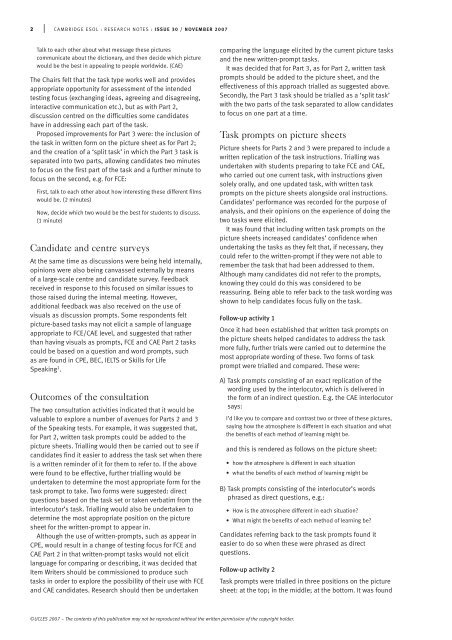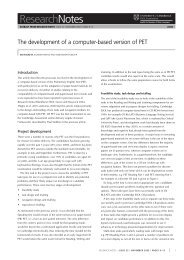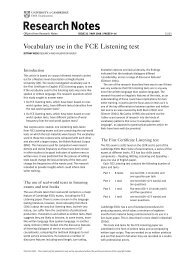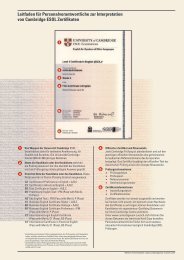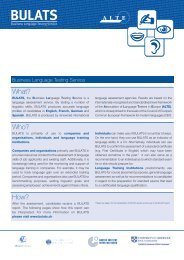Reviewing the FCE and CAE Speaking tests
Reviewing the FCE and CAE Speaking tests
Reviewing the FCE and CAE Speaking tests
Create successful ePaper yourself
Turn your PDF publications into a flip-book with our unique Google optimized e-Paper software.
2 | CAMBRIDGE ESOL : RESEARCH NOTES : ISSUE 30 / NOVEMBER 2007Talk to each o<strong>the</strong>r about what message <strong>the</strong>se picturescommunicate about <strong>the</strong> dictionary, <strong>and</strong> <strong>the</strong>n decide which picturewould be <strong>the</strong> best in appealing to people worldwide. (<strong>CAE</strong>)The Chairs felt that <strong>the</strong> task type works well <strong>and</strong> providesappropriate opportunity for assessment of <strong>the</strong> intendedtesting focus (exchanging ideas, agreeing <strong>and</strong> disagreeing,interactive communication etc.), but as with Part 2,discussion centred on <strong>the</strong> difficulties some c<strong>and</strong>idateshave in addressing each part of <strong>the</strong> task.Proposed improvements for Part 3 were: <strong>the</strong> inclusion of<strong>the</strong> task in written form on <strong>the</strong> picture sheet as for Part 2;<strong>and</strong> <strong>the</strong> creation of a ‘split task’ in which <strong>the</strong> Part 3 task isseparated into two parts, allowing c<strong>and</strong>idates two minutesto focus on <strong>the</strong> first part of <strong>the</strong> task <strong>and</strong> a fur<strong>the</strong>r minute tofocus on <strong>the</strong> second, e.g. for <strong>FCE</strong>:First, talk to each o<strong>the</strong>r about how interesting <strong>the</strong>se different filmswould be. (2 minutes)Now, decide which two would be <strong>the</strong> best for students to discuss.(1 minute)C<strong>and</strong>idate <strong>and</strong> centre surveysAt <strong>the</strong> same time as discussions were being held internally,opinions were also being canvassed externally by meansof a large-scale centre <strong>and</strong> c<strong>and</strong>idate survey. Feedbackreceived in response to this focused on similar issues tothose raised during <strong>the</strong> internal meeting. However,additional feedback was also received on <strong>the</strong> use ofvisuals as discussion prompts. Some respondents feltpicture-based tasks may not elicit a sample of languageappropriate to <strong>FCE</strong>/<strong>CAE</strong> level, <strong>and</strong> suggested that ra<strong>the</strong>rthan having visuals as prompts, <strong>FCE</strong> <strong>and</strong> <strong>CAE</strong> Part 2 taskscould be based on a question <strong>and</strong> word prompts, suchas are found in CPE, BEC, IELTS or Skills for Life<strong>Speaking</strong> 1 .Outcomes of <strong>the</strong> consultationThe two consultation activities indicated that it would bevaluable to explore a number of avenues for Parts 2 <strong>and</strong> 3of <strong>the</strong> <strong>Speaking</strong> <strong>tests</strong>. For example, it was suggested that,for Part 2, written task prompts could be added to <strong>the</strong>picture sheets. Trialling would <strong>the</strong>n be carried out to see ifc<strong>and</strong>idates find it easier to address <strong>the</strong> task set when <strong>the</strong>reis a written reminder of it for <strong>the</strong>m to refer to. If <strong>the</strong> abovewere found to be effective, fur<strong>the</strong>r trialling would beundertaken to determine <strong>the</strong> most appropriate form for <strong>the</strong>task prompt to take. Two forms were suggested: directquestions based on <strong>the</strong> task set or taken verbatim from <strong>the</strong>interlocutor’s task. Trialling would also be undertaken todetermine <strong>the</strong> most appropriate position on <strong>the</strong> picturesheet for <strong>the</strong> written-prompt to appear in.Although <strong>the</strong> use of written-prompts, such as appear inCPE, would result in a change of testing focus for <strong>FCE</strong> <strong>and</strong><strong>CAE</strong> Part 2 in that written-prompt tasks would not elicitlanguage for comparing or describing, it was decided thatItem Writers should be commissioned to produce suchtasks in order to explore <strong>the</strong> possibility of <strong>the</strong>ir use with <strong>FCE</strong><strong>and</strong> <strong>CAE</strong> c<strong>and</strong>idates. Research should <strong>the</strong>n be undertakencomparing <strong>the</strong> language elicited by <strong>the</strong> current picture tasks<strong>and</strong> <strong>the</strong> new written-prompt tasks.It was decided that for Part 3, as for Part 2, written taskprompts should be added to <strong>the</strong> picture sheet, <strong>and</strong> <strong>the</strong>effectiveness of this approach trialled as suggested above.Secondly, <strong>the</strong> Part 3 task should be trialled as a ‘split task’with <strong>the</strong> two parts of <strong>the</strong> task separated to allow c<strong>and</strong>idatesto focus on one part at a time.Task prompts on picture sheetsPicture sheets for Parts 2 <strong>and</strong> 3 were prepared to include awritten replication of <strong>the</strong> task instructions. Trialling wasundertaken with students preparing to take <strong>FCE</strong> <strong>and</strong> <strong>CAE</strong>,who carried out one current task, with instructions givensolely orally, <strong>and</strong> one updated task, with written taskprompts on <strong>the</strong> picture sheets alongside oral instructions.C<strong>and</strong>idates’ performance was recorded for <strong>the</strong> purpose ofanalysis, <strong>and</strong> <strong>the</strong>ir opinions on <strong>the</strong> experience of doing <strong>the</strong>two tasks were elicited.It was found that including written task prompts on <strong>the</strong>picture sheets increased c<strong>and</strong>idates’ confidence whenundertaking <strong>the</strong> tasks as <strong>the</strong>y felt that, if necessary, <strong>the</strong>ycould refer to <strong>the</strong> written-prompt if <strong>the</strong>y were not able toremember <strong>the</strong> task that had been addressed to <strong>the</strong>m.Although many c<strong>and</strong>idates did not refer to <strong>the</strong> prompts,knowing <strong>the</strong>y could do this was considered to bereassuring. Being able to refer back to <strong>the</strong> task wording wasshown to help c<strong>and</strong>idates focus fully on <strong>the</strong> task.Follow-up activity 1Once it had been established that written task prompts on<strong>the</strong> picture sheets helped c<strong>and</strong>idates to address <strong>the</strong> taskmore fully, fur<strong>the</strong>r trials were carried out to determine <strong>the</strong>most appropriate wording of <strong>the</strong>se. Two forms of taskprompt were trialled <strong>and</strong> compared. These were:A) Task prompts consisting of an exact replication of <strong>the</strong>wording used by <strong>the</strong> interlocutor, which is delivered in<strong>the</strong> form of an indirect question. E.g. <strong>the</strong> <strong>CAE</strong> interlocutorsays:I’d like you to compare <strong>and</strong> contrast two or three of <strong>the</strong>se pictures,saying how <strong>the</strong> atmosphere is different in each situation <strong>and</strong> what<strong>the</strong> benefits of each method of learning might be.<strong>and</strong> this is rendered as follows on <strong>the</strong> picture sheet:• how <strong>the</strong> atmosphere is different in each situation• what <strong>the</strong> benefits of each method of learning might beB) Task prompts consisting of <strong>the</strong> interlocutor’s wordsphrased as direct questions, e.g.:• How is <strong>the</strong> atmosphere different in each situation?• What might <strong>the</strong> benefits of each method of learning be?C<strong>and</strong>idates referring back to <strong>the</strong> task prompts found iteasier to do so when <strong>the</strong>se were phrased as directquestions.Follow-up activity 2Task prompts were trialled in three positions on <strong>the</strong> picturesheet: at <strong>the</strong> top; in <strong>the</strong> middle; at <strong>the</strong> bottom. It was found©UCLES 2007 – The contents of this publication may not be reproduced without <strong>the</strong> written permission of <strong>the</strong> copyright holder.


